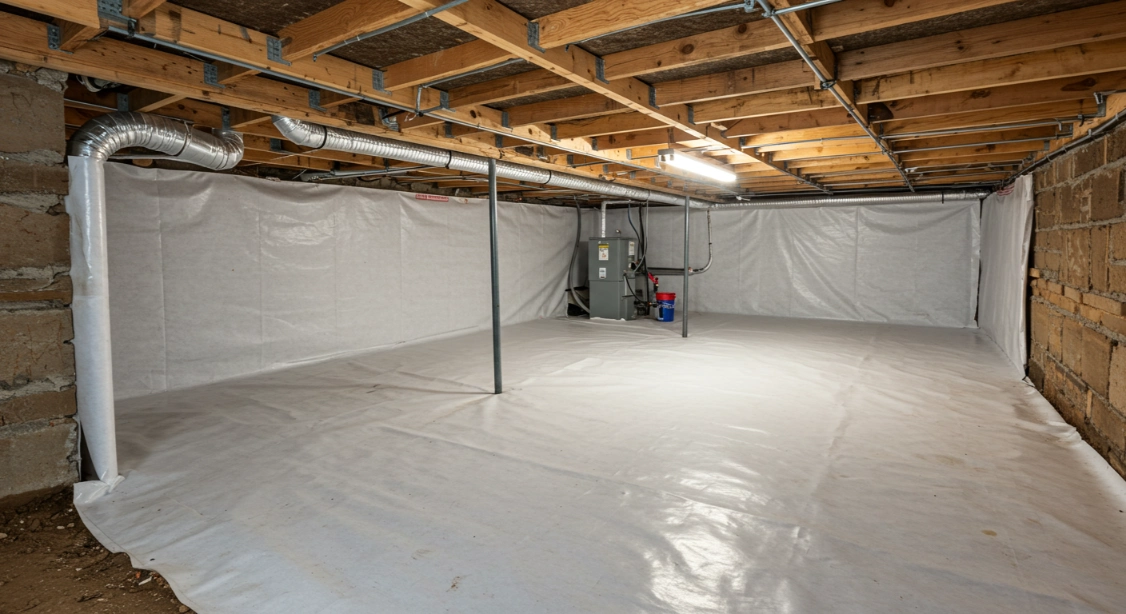Crawl space solutions that measurably improve air quality and energy efficiency include vapor barriers, closed cell spray foam insulation, dehumidifiers, and air sealing. Each plays a distinct role: reducing moisture, controlling temperature, and limiting air infiltration. Combined, these solutions create a sealed, conditioned space that improves indoor air quality and reduces HVAC demand.
The priority is to control moisture and air movement. High humidity in crawl spaces increases microbial growth, which can enter the living space. Poorly insulated or ventilated crawl spaces increase heating and cooling loads. Addressing both simultaneously improves overall building performance.
Field experience in Texas homes has shown a direct correlation between encapsulated crawl spaces and drop in annual energy use. Stellrr Insulation & Spray Foam installs hundreds of crawl space systems yearly and has observed significant IAQ improvements following properly sealed installations.
Discover how Stellrr Insulation & Spray Foam’s Crawl Space Insulation Services enhances air quality, prevents moisture damage, and boosts long-term energy savings.
Key Crawl Space Solutions and Performance Comparison
| Solution Type | Primary Function | Impact on Air Quality | Impact on Energy Efficiency | Typical Lifespan | Maintenance Needs |
|---|---|---|---|---|---|
| Vapor Barrier | Moisture control | High | Moderate | 20+ years | Low (inspect annually) |
| Closed Cell Spray Foam | Air seal + insulation | High | High | 30+ years | Very low |
| Dehumidifier (crawl-rated) | Humidity regulation | High | Low | 8-10 years | Moderate (filter, pan) |
| Air Sealing (rim/band joist) | Prevents infiltration | Moderate | Moderate | 20+ years | Low |
| Fiberglass Batts | Basic thermal resistance | Low | Low | 10-15 years | High (prone to mold) |
How Moisture Management Affects Indoor Air Quality
Moisture creates an ideal environment for mold, mildew, and dust mites. These biological contaminants often rise into the living area through the stack effect. Crawl spaces in humid climates like Central Texas are particularly vulnerable.
Using vapor barriers on the floor and closed cell spray foam on walls and rim joists creates a sealed environment. This reduces the potential for airborne spores and musty odors to infiltrate the home. Crawl space dehumidifiers are often added to maintain relative humidity optimal for air quality.
Bonus Tip: Avoid using vented crawl spaces in humid regions. Venting introduces unconditioned air and can worsen condensation issues.
Energy Efficiency Improvements from Sealed Crawl Spaces
Conditioned crawl spaces reduce heat loss in winter and heat gain in summer. Closed cell spray foam has a high R-value per inch (R-6 to R-7), acting as both insulation and vapor retarder.
Based on Department of Energy (DOE) data, homes with insulated, sealed crawl spaces in warm climates reduce HVAC use. Stellrr Insulation & Spray Foam’s field audits align with these findings, showing HVAC run-time reductions and improved temperature consistency.
| Material / System | R-Value per Inch | Water Permeance | Air Sealing Capacity | Typical Install Location |
|---|---|---|---|---|
| Closed Cell Spray Foam | 6.5–7.0 | <1.0 perm | Excellent | Walls, rim joists |
| Vapor Barrier (20 mil) | N/A | 0.03 perm | None | Crawl floor |
| Fiberglass Batt | ~3.5 | N/A | Poor | Joist bays (not advised) |

Things to Consider Before Making a Decision
- Climate: Humid regions (like Austin) benefit more from full encapsulation. Dry regions may only require partial solutions.
- Foundation Design: Pier-and-beam homes often need insulation at both walls and floors.
- Existing Conditions: Standing water or heavy mold needs to be addressed before insulation.
- Access and Clearance: Tight crawl spaces may limit equipment options.
- Budget: Closed cell spray foam is more costly but delivers better air sealing and longevity.
Bonus Tip: Always test for moisture levels before installing any insulation. High levels can trap water and worsen air quality.
Closely Related Services Offered by Stellrr Insulation & Spray Foam
- Crawl Space Insulation: Install high-performance insulation for better thermal resistance and reduced air leakage.
- Closed Cell Spray Foam: Applied to crawl space walls and joists to seal gaps and insulate in one step.
- Insulation Removal: Safely removes contaminated or ineffective materials like fiberglass batts.
- Open Cell Insulation: Suitable for certain subfloors when combined with other sealing measures.
Common Questions People Ask Before Making a Decision
What’s the difference between vented and sealed crawl spaces?
Vented spaces allow air from outside to enter, often increasing humidity and mold risk. Sealed spaces block outside air and control moisture internally.
Is crawl space encapsulation worth the cost?
In humid areas, yes. Encapsulation improves comfort, air quality, and HVAC efficiency, often offsetting cost over time.
Do I need a dehumidifier after sealing the crawl space?
Yes, in most cases. Even with air sealing, humidity from soil can raise levels. A dehumidifier maintains optimal RH.
Can I insulate a crawl space without removing old fiberglass?
It’s not recommended. Old insulation can trap moisture and harbor mold, reducing the effectiveness of new materials.
Get Expert Insulation Guidance
Contact Stellrr Insulation & Spray Foam for expert solutions based on real-world performance data and installation experience in Central Texas homes.
Phone: (512) 710-2839 Email: info@stellrr.com
Frequently Asked Questions
How long does a crawl space insulation system last?
Closed cell spray foam lasts over 30 years with minimal maintenance. Vapor barriers can last 20+ years if undisturbed.
Can sealed crawl spaces cause indoor air problems?
Not when properly ventilated with air exchange or dehumidifiers. Poor installation, however, can trap pollutants.
What’s the best way to monitor crawl space conditions over time?
Install a hygrometer to measure humidity and inspect for condensation or odors twice a year.
How often should I inspect my crawl space insulation?
Annually. Look for signs of moisture, mold, or physical damage to insulation or vapor barriers.
Does local code in Texas allow sealed crawl spaces?
Yes. As long as moisture control and air management standards are met, sealed crawl spaces comply with IRC and state codes.

